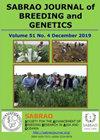新植物型水稻(oryza sativa l .)的遗传结构这些线条是基于12年的多项实验
IF 1.7
Q3 PLANT SCIENCES
引用次数: 0
摘要
新型水稻(NPT)可以在全球范围内提高粮食产量。尽管许多研究表明了水稻的收获和产量相关性状之间的联系,但在NPT水稻的情况下,这种联系仍然不清楚。本研究旨在通过12年的多品种试验,阐明新型水稻农艺性状与产量性状的关系。对来自24个不同种群的704个不同世代(F4至F10)的NPT水稻品系进行了研究。方差分析表明,各性状的群体效应极显著(P < 0.01)。NPT水稻群体可分为4个群体,总分蘖数(NTT)、总粒数(NTG)、灌浆粒数(NFG)和千粒重(TGW)均存在显著的群体效应(P < 0.01)。每次试验的标准最佳NPT品系平均产量为1.67 t hm -1,比慈和让品系高出26%。决定NPT品系产量优势的因素是较高的株高(PH) (r = 0.37)、穗长(PL) (r = 0.15)、NTG (r = 0.28)、NFG (r = 0.28)、TGW (r = 0.10)和较短的收获天数(r = -0.10)。主成分分析双图显示,NFG能更好地作为适应热带灌溉生态系统的NPT水稻增产的选择特征。本文章由计算机程序翻译,如有差异,请以英文原文为准。
GENETIC ARCHITECTURE OF NEW PLANT TYPE RICE (ORYZA SATIVA L.) LINES BASED ON A 12-YEARS MULTI-EXPERIMENT
New plant-type (NPT) rice can increase grain yield globally. Although many studies have shown the association between harvest and yield-related traits in rice, it remains obscure in the case of NPT rice. This study aimed to elucidate the relationship between agronomic and yield features in new plant-type rice based on a 12-years multi-experiment. A large dataset of 704 NPT rice lines of various generations (F4 to F10), derived from 24 different populations, underwent study. The analysis of variance showed a highly significant population effect (P < 0.01) on all traits studied. The NPT rice populations had groupings into four clusters, with a highly substantial cluster effect (P < 0.01) on the number of total tillers (NTT), number of total grains (NTG), number of filled grains (NFG), and thousand-grain weight (TGW). Standard best NPT lines from each experiment achieved an average of 1.67 t ha-1 or 26% higher yield than the Ciherang variety. Determining the yield advantage of NPT lines was by higher plant height (PH) (r = 0.37), panicle length (PL) (r = 0.15), NTG (r = 0.28), NFG (r = 0.28), TGW (r = 0.10), and lower days to harvest (DTH) (r = -0.10). The principal component analysis biplot revealed that NFG could better serve as a selection characteristic for enhancing grain yield in developing NPT rice adapted to irrigated tropical ecosystems.
求助全文
通过发布文献求助,成功后即可免费获取论文全文。
去求助
来源期刊

Sabrao Journal of Breeding and Genetics
农林科学-奶制品与动物科学
CiteScore
1.90
自引率
50.00%
发文量
63
期刊介绍:
The SABRAO Journal of Breeding and Genetics is an international journal of plant breeding and genetics research and was first published in 1969. It is the official publication of the Society for the Advancement of Breeding Research in Asia and Oceania (SABRAO).
Its objectives are to: promote the international exchange of research information on plant breeding and genetics, by describing new research findings, or ideas of a basic or practical nature; and be a medium for the exchange of ideas and news regarding members of the Society.
The Journal gives priority to articles that are of direct relevance to plant breeders and with emphasis on the Asian region. Invited for publication are research articles, short communications, methods, reviews, commentaries, and opinion articles. Scientific contributions are refereed and edited to international standards.
The journal publishes articles for SABRAO members mainly. The Journal preferred strongly that at least one author should be a current member of the Society. Non-members may also publish in the journal.
 求助内容:
求助内容: 应助结果提醒方式:
应助结果提醒方式:


